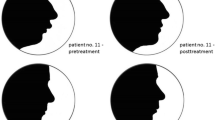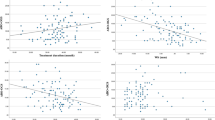Abstract
The aim of this study was to assess the success of arthodontic treatment of pronounced Angle Class III malocclusions. The records of 16 patients with pretreatment mesial occlusion and negative overjet were analyzed by evaluating the plaster casts and lateral cephalograms made at the beginning (B1) and end (B2) of active treatment, which was purely orthodontic in all cases. After treatment the patients were divided into 2 groups: group 1 (n=10) with virtually ideal occlusal relationships, and group 2 (n=6) where this was not the case. Professional assessment of the results using the Peer Assessment Rating (PAR) Index revealed a reduction of the weighted PAR scores of 90.2% in group 1 and 68.8% in group 2. A questionnaire was specially designed to obtain information on the patient's rating of the treatment and of the treatment outcome. 75% of the patients addressed answered the questionnaire. Following correction of the frontal crossbites, both groups displayed a clear-cut improvement of the sagittal lip relationship; this sometimes had a striking effect on the facial esthetics.
The size and heterogeneity of the sample permit only cautious interpretation of the results. However, the study suggests from what degree of Angle Class III malocclusion surgical intervention is more likely to be indicated, although the final decision on elective surgery of this kind must always be left to the patient. The PAR Index offers various advantages in assessing treatment results. However, in view of its lack of esthetic sensitivity, it should be supplemented by other assessment methods.
Zusammenfassung
Ziel der Studle war es, den Erfolg der kieferorthopädischen Therapie bei markanten Abweichungen der Angle-Klasse III zu beurteilen. Es wurden die diagnostischen Unterlagen von 16 Patienten analysiert, bei welchen zu Beginn eine Mesialokklusion und ein umgekehrter Frontzahnüberbiß vorlagen. Dabei wurden am Anfang (B1) und zum Abschluß (B2) der aktiven Behandlung, die in allen Fällen rein kieferorthopädisch erfolgte, die angefertigten Modelle und Fernröntgenseitenbilder ausgewertet. Die Patienten wurden nach der Behandlung in zwei Gruppen unterteilt, wobei in Gruppe 1 (n=10) annähernd ideale Okklusionsverhältnisse erreicht wurden, was in Gruppe 2 (n=6) nicht der Fall war. Die professionelle Beurteilung der Ergebnisse mit dem Peer-Assessment-Rating-(PAR-)Index ergab in Gruppe 1 eine Reduktion des gewichteten PAR-Wertes von 90,2% sowie von 68,8% in Gruppe 2. Ein speziell konzipierter Fragebogen sollte Erkenntnisse über die Einschätzung der Behandlung und des Behandlungsergebnisses aus der Sicht des Patienten liefern. Es antworteten 75% der angeschriebenen Patienten. Nach Korrektur des frontalen Kreuzbisses kam es in beiden Gruppen zu einer deutlichen Verbesserung der sagittalen Lippenrelation, was sich teilweise markant auf die Gesichtsästhetik auswirkte.
Die Größe und Heterogenität der Stichprobe lassen nur eine vorsichtige Interpretation der Ergebnisse zu. Jedoch könnte die Untersuchung Hinweise liefern, ab welchem Schweregrad einer Angle-Klasse III eher eine chirurgische Intervention indiziert ist, wobei die letzte Entscheidung über einen solchen “Wahleingriff” immer auf seiten des Patienten liegt. Der PAR-Index bietet für die Beurteilung von Behandlungsergebnissen einige Vorteile, er sollte aber wegen mangelnder Sensitivität, was die Ästhetik betrifft, durch weitere Bewertungsmethoden ergänzt werden.
Similar content being viewed by others
References
Berg R. Postretention analyzes of treatment problems and failures in 264 consecutively treated cases. Eur J Orthodont 1979; 1:55–68.
Berg R, Fredlund A. Evaluation of orthodontic treatment results. Eur J Orthodont 1981;3:181–5.
Berg R. Nachkontrolle von kieferorthopädischer Behandlung bei 21 Patienten mit Angle-Klasse III-Malokklusion. Inf Orthodont Kieferorthop 1986;18:229–37.
Berg R. Die Bewertung von kieferorthopädischen Behandlungsergebnissen. Inf Orthodont Kieferorthop 1990;22:483–7.
Berg R. Evaluation of orthodontic results-a discussion of some methodological aspects. Angle Orthodont 1991;61: 261–6.
Birkeland K, Bøe OE, Wisth PJ. Subjektive Bewertung von dentalen und psychosozialen Ergebnissen nach kieferorthopädischer Behandlung. J Orofac Orthop/Fortschr Kieferorthop 1997;58:44–61.
Björk A, Skieller V. Normal and abnormal growth of the mandible. A synthesis of longitudinal cephalometric implant studies over a period of 25 years. Eur J Orthodont 1983;5:1–46.
Brook PH, Shaw WC. The development of an index for orthodontic treatment priority. Eur J Orthodont 1989;11:309–20.
Buchanan IB, Russell JI, Clark JD. Practical application of the PAR index: an illustrative comparison of the outcome of treatment using 2 fixed appliance techniques. Br J Orthodont 1996;23:351–7.
Byloff Clar H. Ergebnisse verschiedener Progeniebehandlungen. Fortschr Kieferorthop 1971;32:471–82.
Canut JA, Plascenia E, Asensi C. Langfristige Stabilität behandelter Klasse III-Fälle. Inf Orthodont Kieferorthop 1985;17: 177–83.
Dahlberg G. Statistical methods for medical and biological students. New York: Interscience Publ., 1940.
DeGuzman L, Bahiraei D, Vig KWL, et al. The validation of the Peer Assessment Rating index for malocclusion severity and treatment difficulty. Am J Orthodont Dentofac Orthop 1995;107:172–6.
Eisel A, Katsaros C, Berg R. Verlauf und Ergebnisse der KFO-Behandlung bei 44 fortlaufend abgeschlossenen Klasse-II-Fällen. Fortschr Kieferorthop 1994;55:1–8.
Friedrichs J. Methoden empirischer Sozialforschung. Oplanden: Westdeutscher Verlag, 1980.
Jacobson A. The “Wits” appraisal of jaw disharmony. Am J Orthodont 1975;67:125–38.
Jäger A, Flechsig G, Luhr HG. Motivation und Erfahrung von Patienten im Zusammenhang mit einer kieferorthopädisch-kieferchirurgischen Kombinationstherapie. Patientenbefragung unter Berücksichtigung klinischer und psychosozialer Faktoren. Fortschr Kieferorthop 1995;56:265–73.
Karageorgiou N, Pancherz H. Auswertung kieferorthopädischer Behandlungsergebnisse. Inf Orthodont Kieferorthop 1996;28:311–26.
Korkhaus G. Die Häufigkeit der orthodontischen Anomalien in verschiedenen Lebensaltern. Dtsch Monatsschr Zahnheilk 1927;45:508–24.
Profft WR. Diagnosis and treatment planning. In: Graber TM, Swain BF, eds. Orthodontics: current principles and techniques. St. Louis-Baltimore-Boston-Chicago-London-Madrid-Philadelphia-Sydney-Toronto: C.V. Mosby, 1994:16–6.
Richmond S, Shaw WC, Roberts CT, et al. The PAR index (Peer Assessment Rating): methods to determine outcome of orthodontic tretment in terms of improvement and standards. Eur J Orthodont 1992;14:180–7.
Schopf PM. Fruhsymptome der progenen Entwicklung. Fortschr Kieferorthop 1971;32:437–51.
Schulhof RJ, Nakamura S, Williamson WV. Prediction of abnormal growth in Class III malocclusions. Am J Orthodont 1977;71:421–30.
Sergl HG. Experimentalpsychologische Untersuchungen zur Ausdruckswirkung des Gesichtsprofils. Dtsch zahnärztl Z 1968;23:414–24.
Taylor PJ, Kerr WJ, McColl JH. Factors associated with the standard and duration of orthodontic treatment. Br J Orthodont 1996;23:335–41.
Wilhelm-Nold I, Droschl H. Die Frühbehandlung der Progenie im Milchgebiß im Vergleich zur Behandlung im Wechselgebiß. Fortschr Kieferorthop 1990;51:165–79.
Author information
Authors and Affiliations
Rights and permissions
About this article
Cite this article
Angermann, R., Berg, R. Evaluation of orthodontic treatment success in patients with pronounced angle class III. J Orofac Orthop/Fortschr Kieferorthop 60, 246–258 (1999). https://doi.org/10.1007/BF01299783
Received:
Accepted:
Issue Date:
DOI: https://doi.org/10.1007/BF01299783




